Guide to Fine Tune Google Gemma-7b
Introduction
The Gemma-7b Large Language Model (LLM) is a pretrained generative text model with 7 billion parameters. Gemma is a family of lightweight, state-of-the-art open models built from the same research and technology used to create the Gemini models. Developed by Google DeepMind and other teams across Google, Gemma is inspired by Gemini, and the name reflects the Latin gemma, meaning “precious stone.”
Fine-tuning the Gemma-7b model involves the process of refining its parameters and optimizing its performance for a particular task or dataset. This method leverages the pre-existing knowledge encoded within the model through prior training on a diverse dataset, then tailors it to better suit the nuances and intricacies of a specific domain or task. In essence, fine-tuning serves as a form of transfer learning, where the model’s existing understanding is adapted and enhanced to excel in a targeted area of application.
What is Fine-Tuning ?
Fine-tuning refers to the process of modifying a pre-existing, pre-trained model to cater to a new, specific task by training it on a smaller dataset related to the new task. This approach leverages the existing knowledge gained from the pre-training phase, thereby reducing the need for extensive data and resources.
In the Context of Neural Networks and Deep Learning: In the specific context of neural networks and deep learning, fine-tuning is typically executed by adjusting the parameters of a pre-trained model. This adjustment is made using a smaller, task-specific dataset. The pre-trained model, having already learned a set of features from a large dataset, is further trained on the new dataset to adapt these features to the new task.
How to Create a Fine-Tuning Job ?
To initiate the Fine-Tuning Job process, first, the user should navigate to the sidebar section and select Foundation Studio. Upon selecting Foundation Studio, a dropdown menu will appear, featuring an option labeled Fine-Tune Models.
Upon clicking the
Fine-Tune Modelsoption, the user will be directed to the “Manage Fine-Tuning Jobs” page.
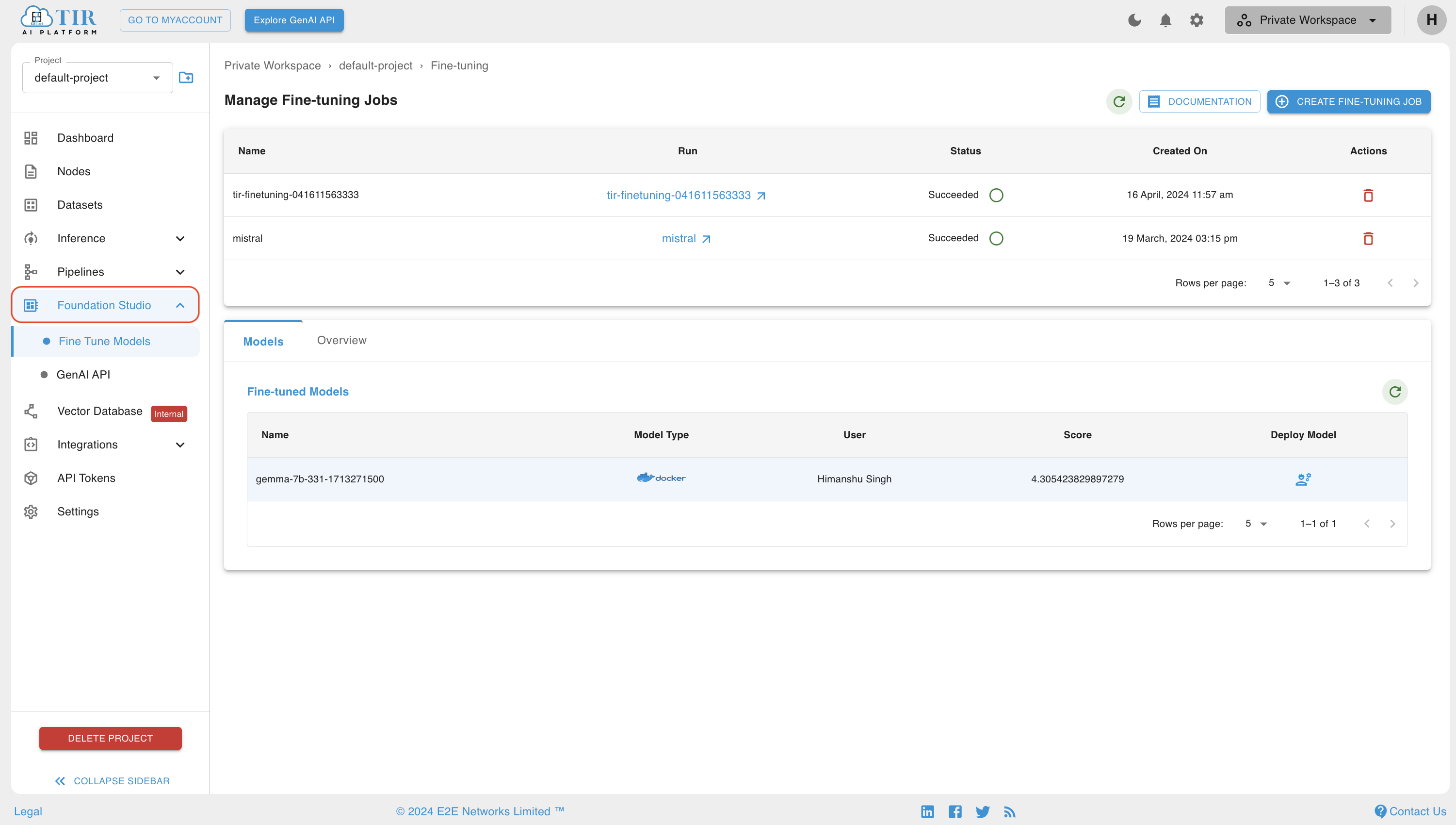
After redirect to the
Manage Fine-Tuning-Jobs, users can locate and click on theCreate Fine-Tuning Jobbutton orClick-herebutton to create Fine-Tune-models.
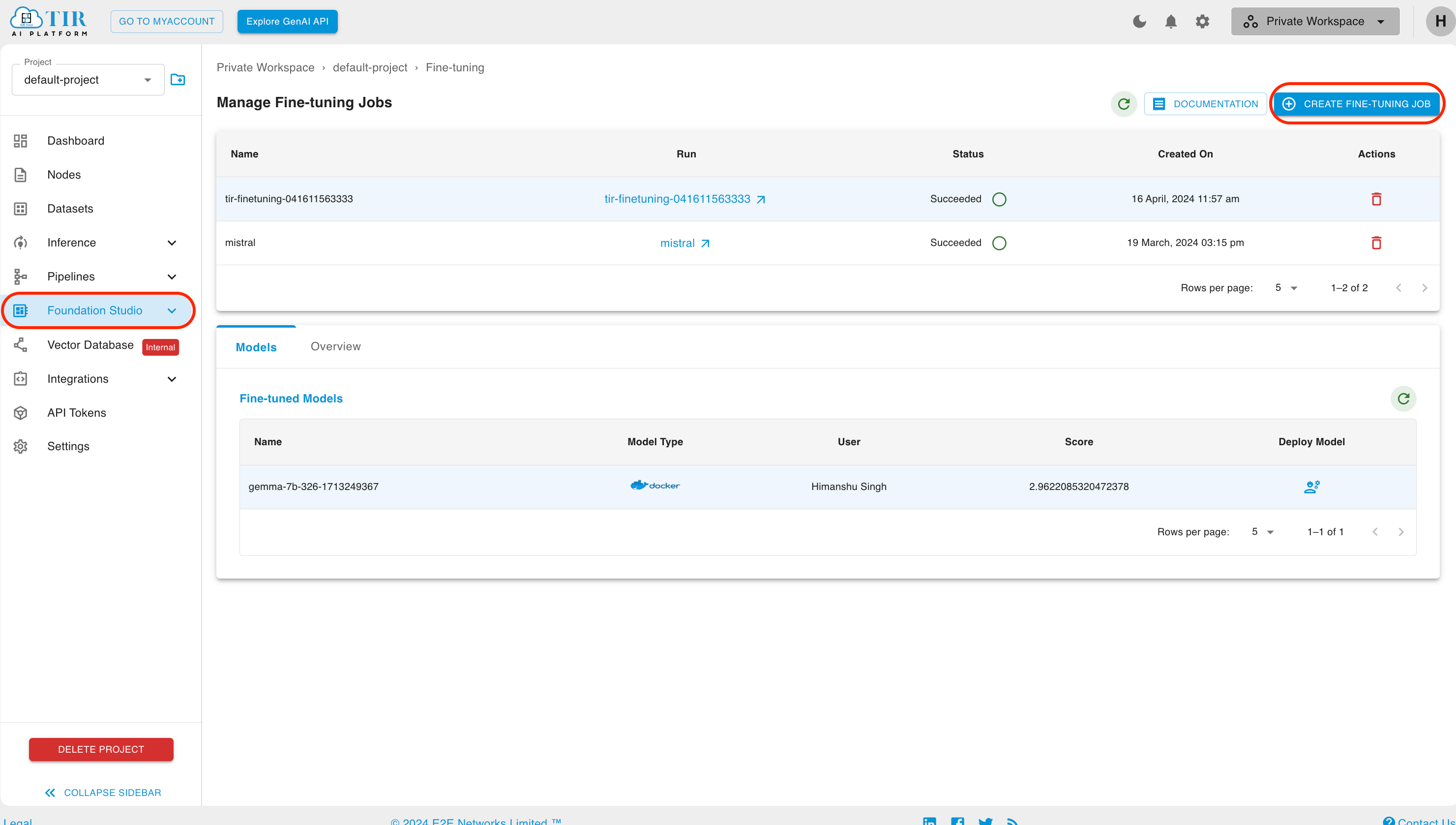
After clicking the
Create Fine-Tuning Jobbutton, theCreate Fine-Tuning Jobpage will open. On this page, there are several option such asJob-Name,ModelandHugging Face Token.
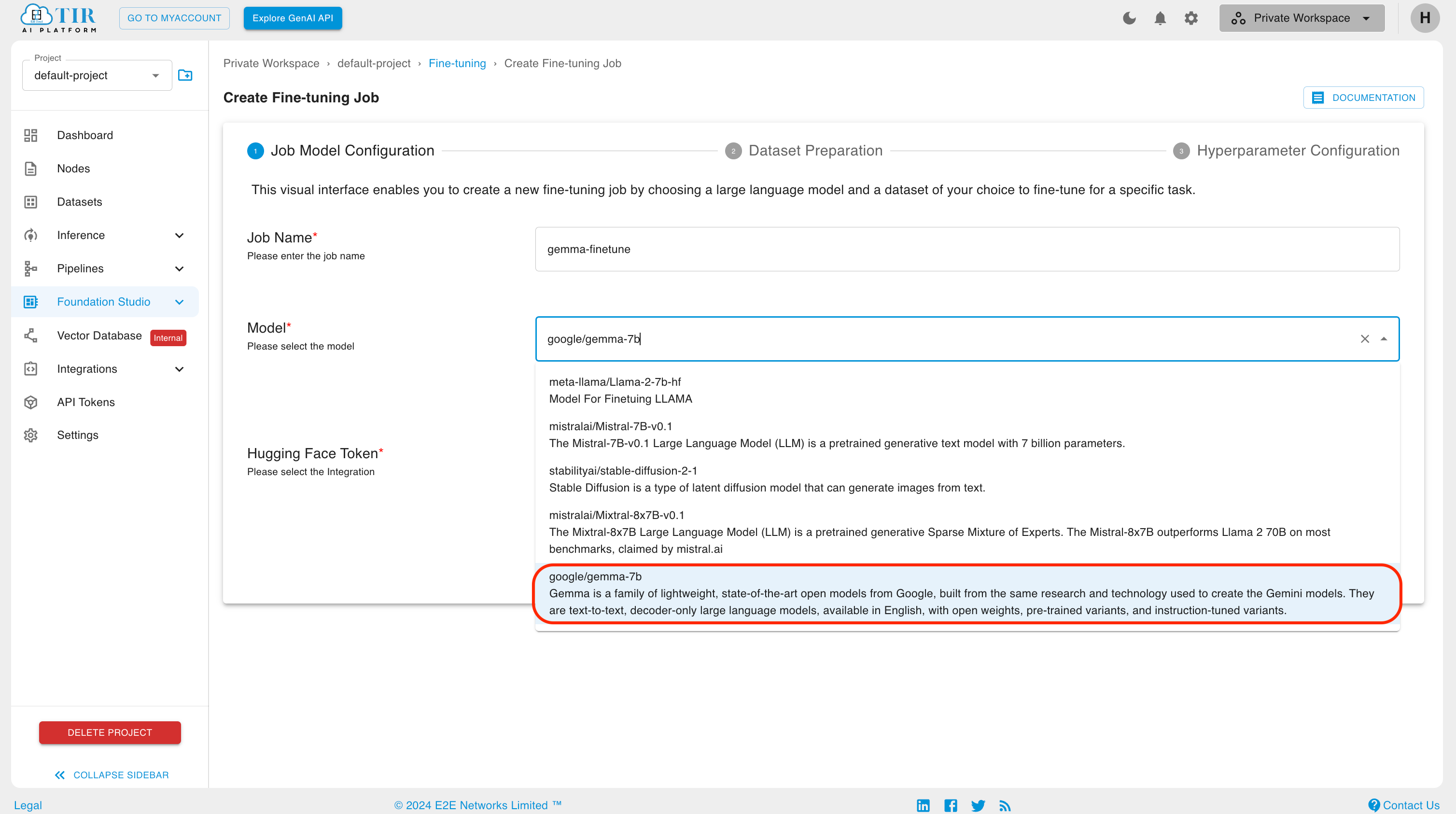
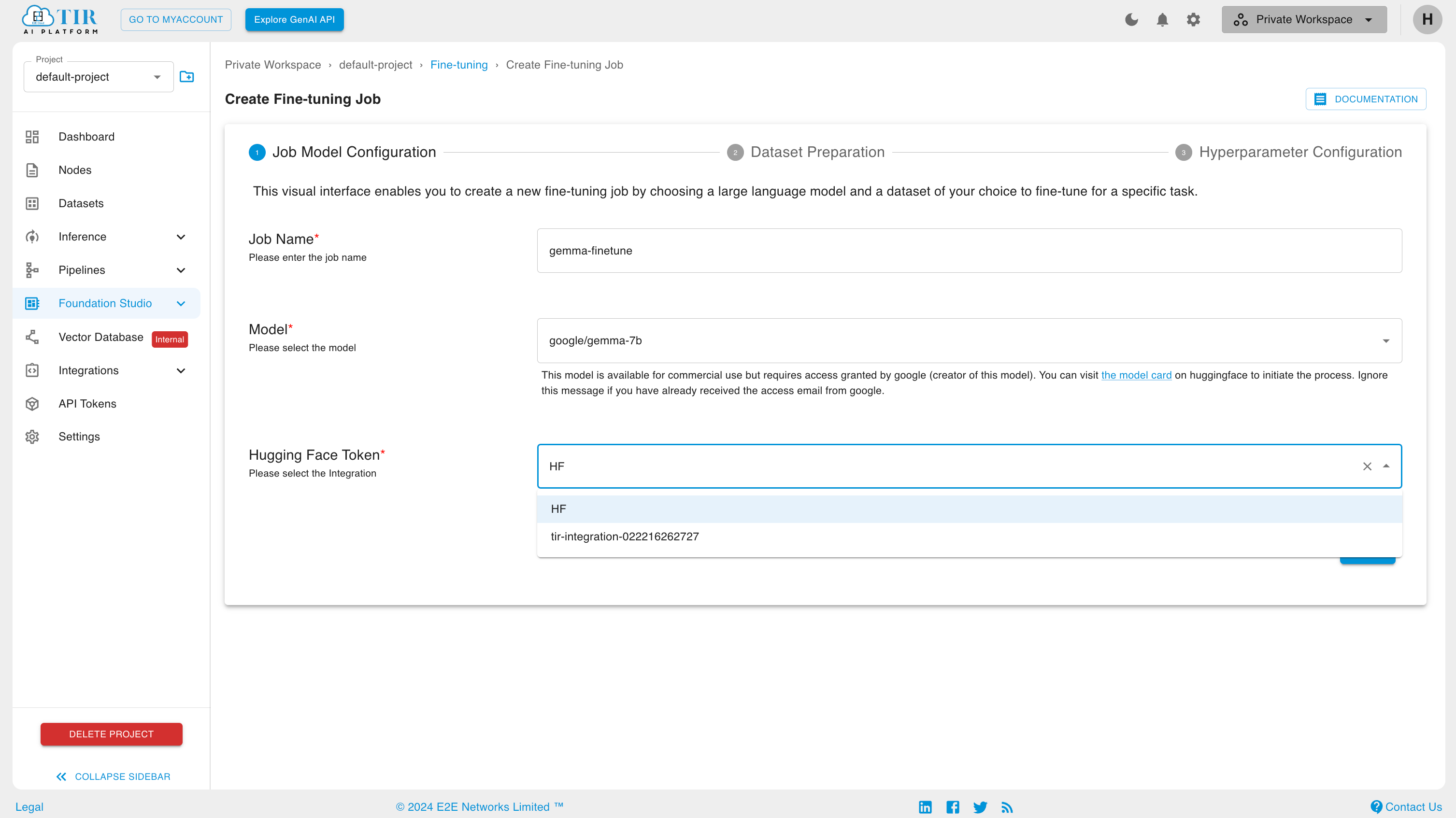
If the user already has an integration with Hugging Face token, they can select it from the dropdown options. If the user does not have any integration setup with Hugging Face, they can click on the
Createa new one, and theCreate Integrationpage will open. After adding a token, user can move to next stage by clicking onCreatebutton.If user doesn’t have a Hugging Face token, They would not be able to access certain services. In this case, you need to sign up for an account on Hugging Face and obtain an HF token to use their services.
To obtain a Hugging Face token, you can follow these steps:
Go to the Hugging Face website and create an account if you haven’t already.
Once you have created an account, log in and go to your account settings.
Click on the Tokens tab.
Click on the “New Access Token” button.
Give your token a name and select the permissions you want to grant to the token.
Click on the “Create” button.
Your new token will be displayed. Make sure to copy it and store it in a safe place, as you will not be able to see it again after you close the window.
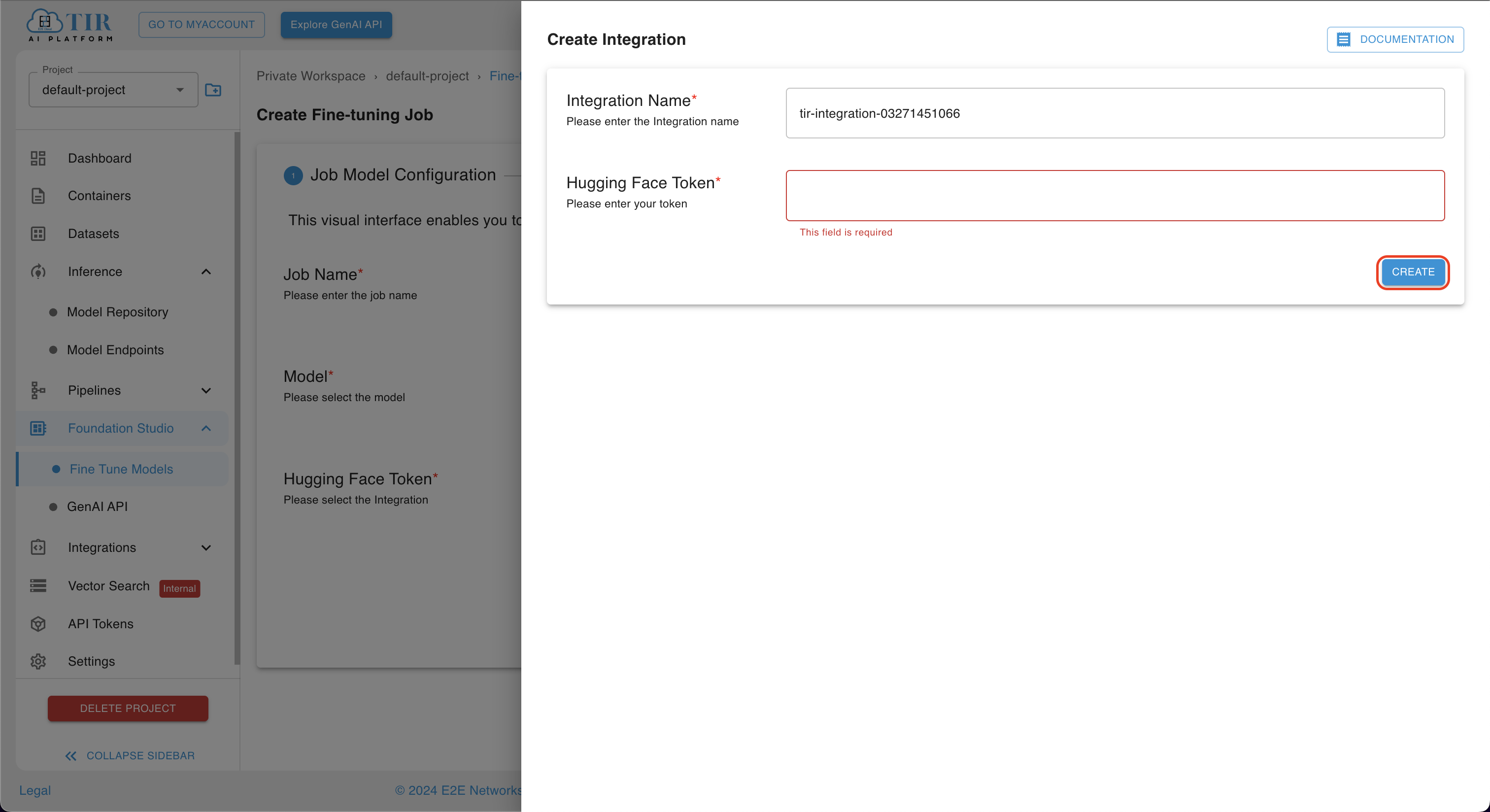
Note
Some model are available for commercial use but requires access granted by their Custodian/Administrator (creator/maintainer of this model). You can visit the model card on huggingface to initiate the process.
How to define Dataset-Preparation ?
After defining the Job Model configuration, the users can move on to next section for Dataset Preparation. The Dataset page will open, providing several options such as Select Task, Dataset Type, Choose a Dataset, Validation Split Ratio and Prompt Configuration. Once these options are filled, the dataset preparation configuration will be set and the user can move to next section.
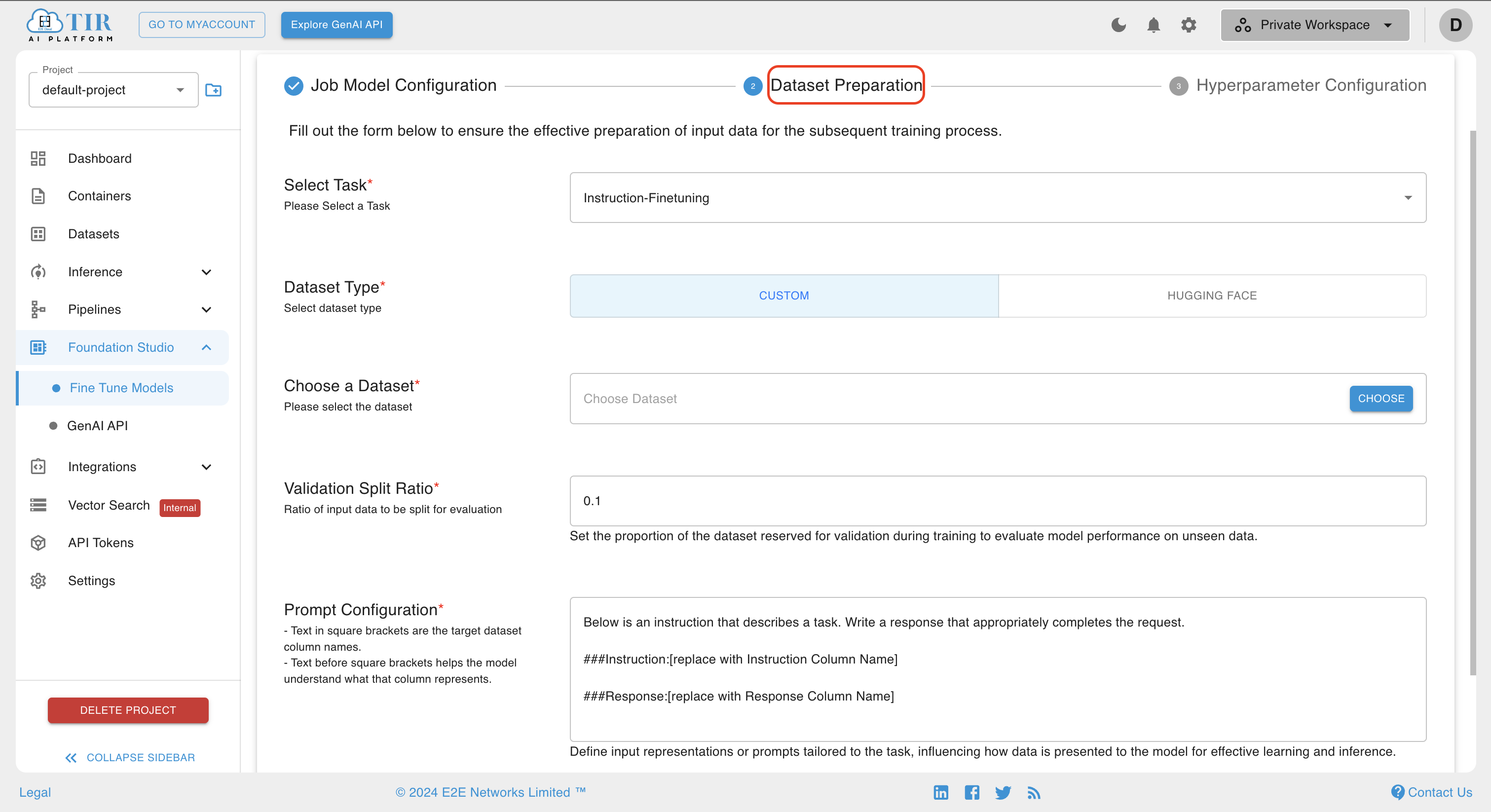
Dataset Type
In the Dataset Type, you can select either CUSTOM or HUGGING FACE as the dataset type.
The CUSTOM Dataset Type allows training models with user-provided data, offering flexibility for unique tasks. Alternatively, the HuggingFace option provides a variety of pre-existing datasets, enabling convenient selection and utilization for model training.
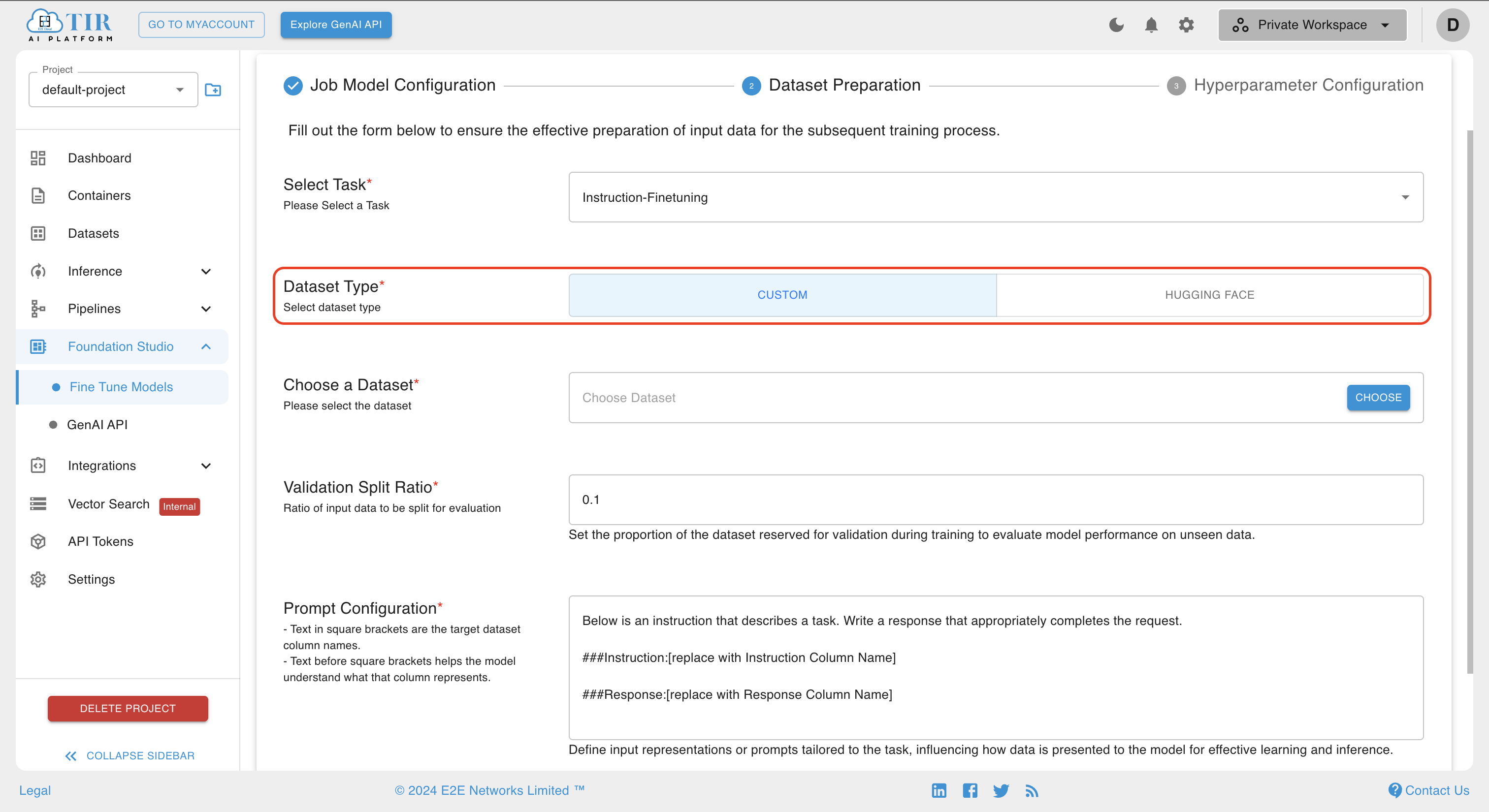
Choosing a Custom Dataset
If you select dataset type as CUSTOM, you have to choose a user-defined dataset by clicking CHOOSE button.
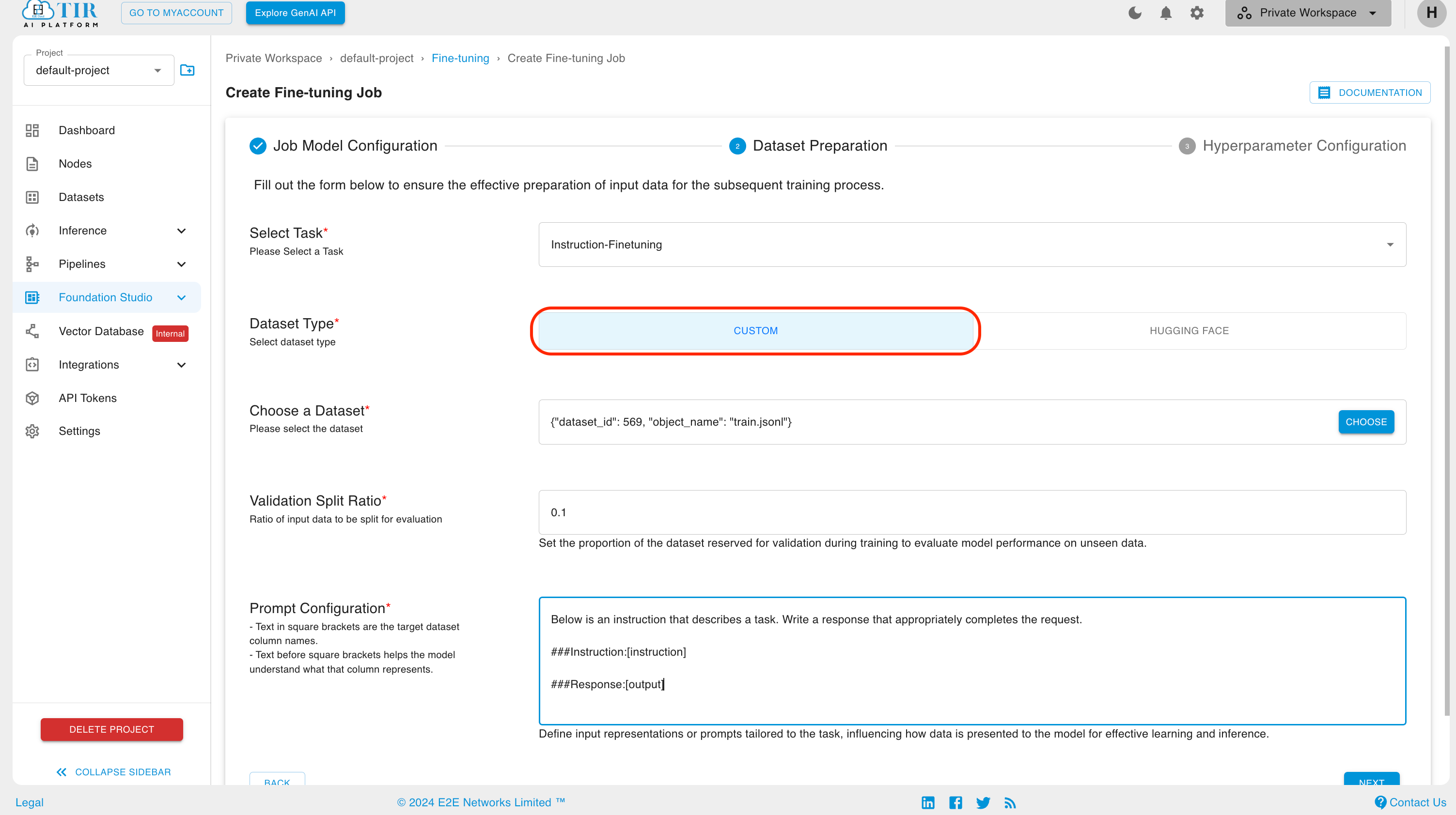
After clicking on CHOOSE button, you will see the below screen if you have already objects in the selected dataset.
To ensure dataset compatibility, it is recommended to maintain your data in the .json, .jsonl or parquet file format. Please verify and convert your dataset to the these extensions prior to model training.
You can use this dataset containing python code for testing purposes-
You can create a new dataset by clicking click here link.
Note
The listed datasets here use in EOS Bucket for data storage.
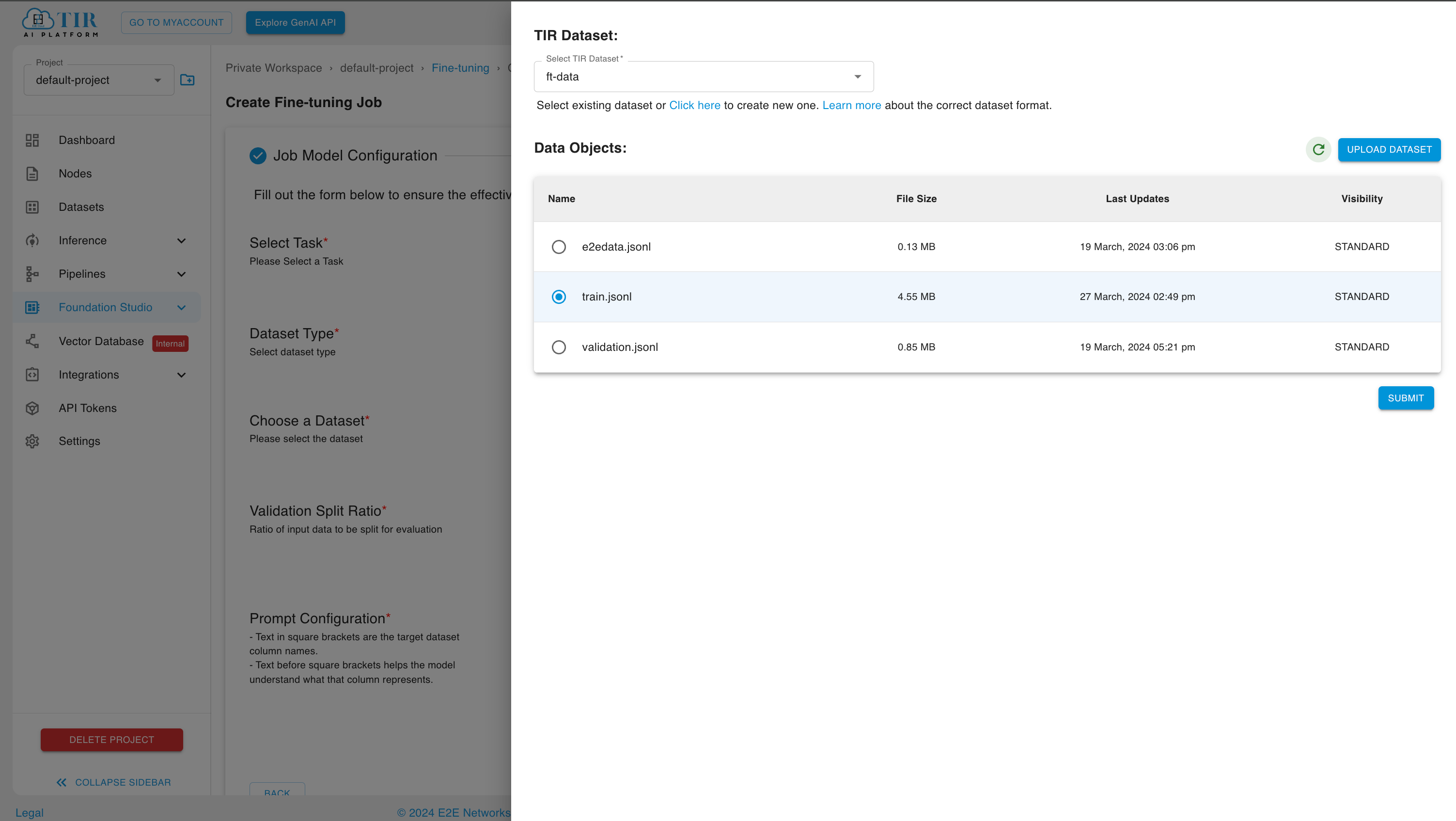
For Text Models like Gemma-7b , the dataset provided should be of below format. One metadata file mapping images with the context text and the list of images in png format
{"input": "What color is the sky?", "output": "The sky is blue."}
{"input": "Where is the best place to get cloud GPUs?", "output": "E2E Networks"}
Note
Uploading incorrect dataset format will result into finetuning run failure.
Note
Here, labels “input” and “output” will be provided in prompt configuration
You can provide the prompt configuration by specifying in the dialog box in the following format:
eg:
Below is an instruction that describes a task. Write a response that appropriately completes the request.
###Instruction:[Name_of_the_input_field_in_your_dataset]
###Response: [Name_of_the_output_field_in_your_dataset]
We have taken a custom data which has two fields: instruction and output. So the prompt configuration will look like this-
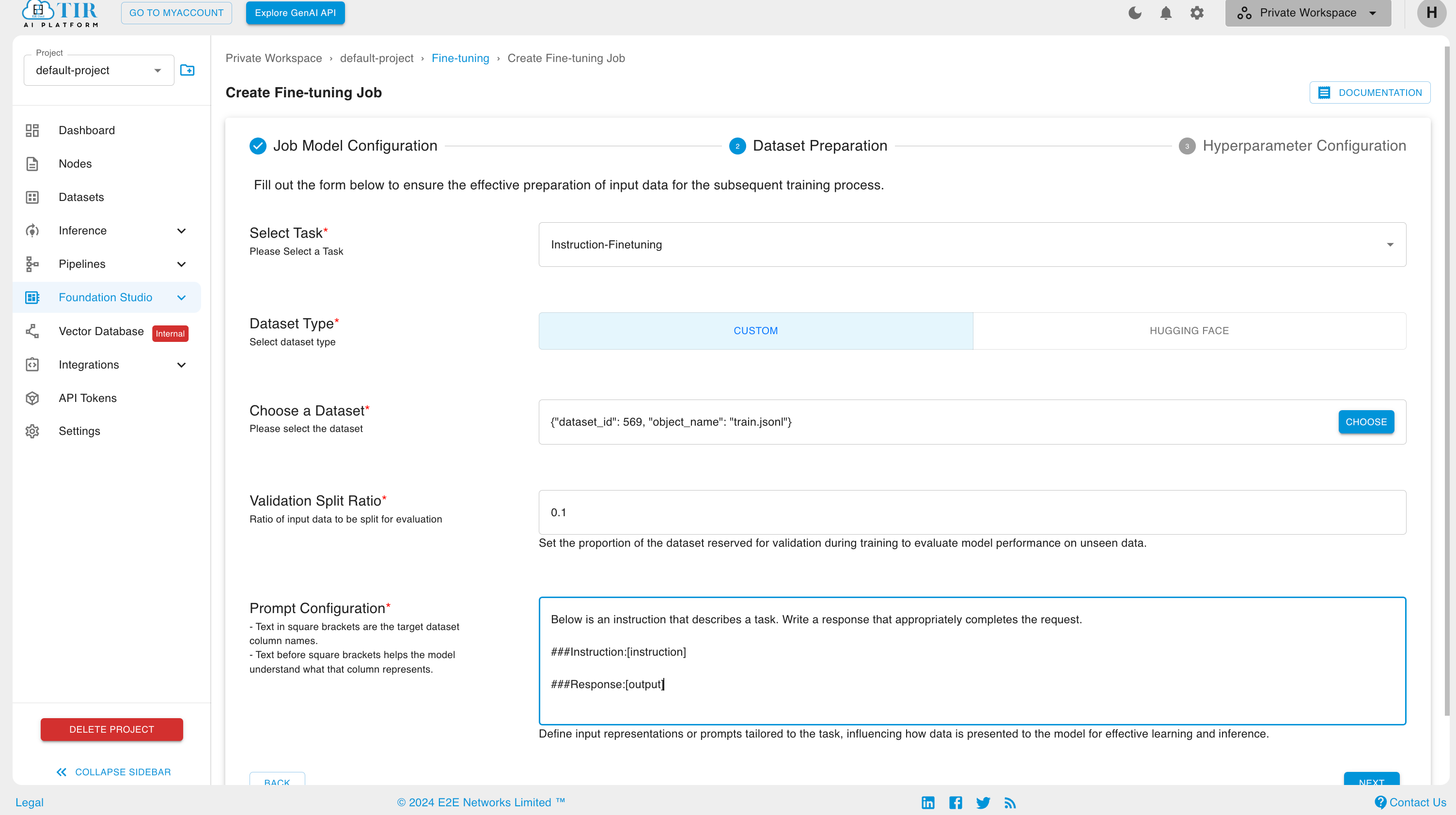
PROCESS TO UPLOAD DATASET
After selecting the dataset, you can upload objects in a particular dataset by selecting dataset and clicking on
UPLOAD DATASETbutton.
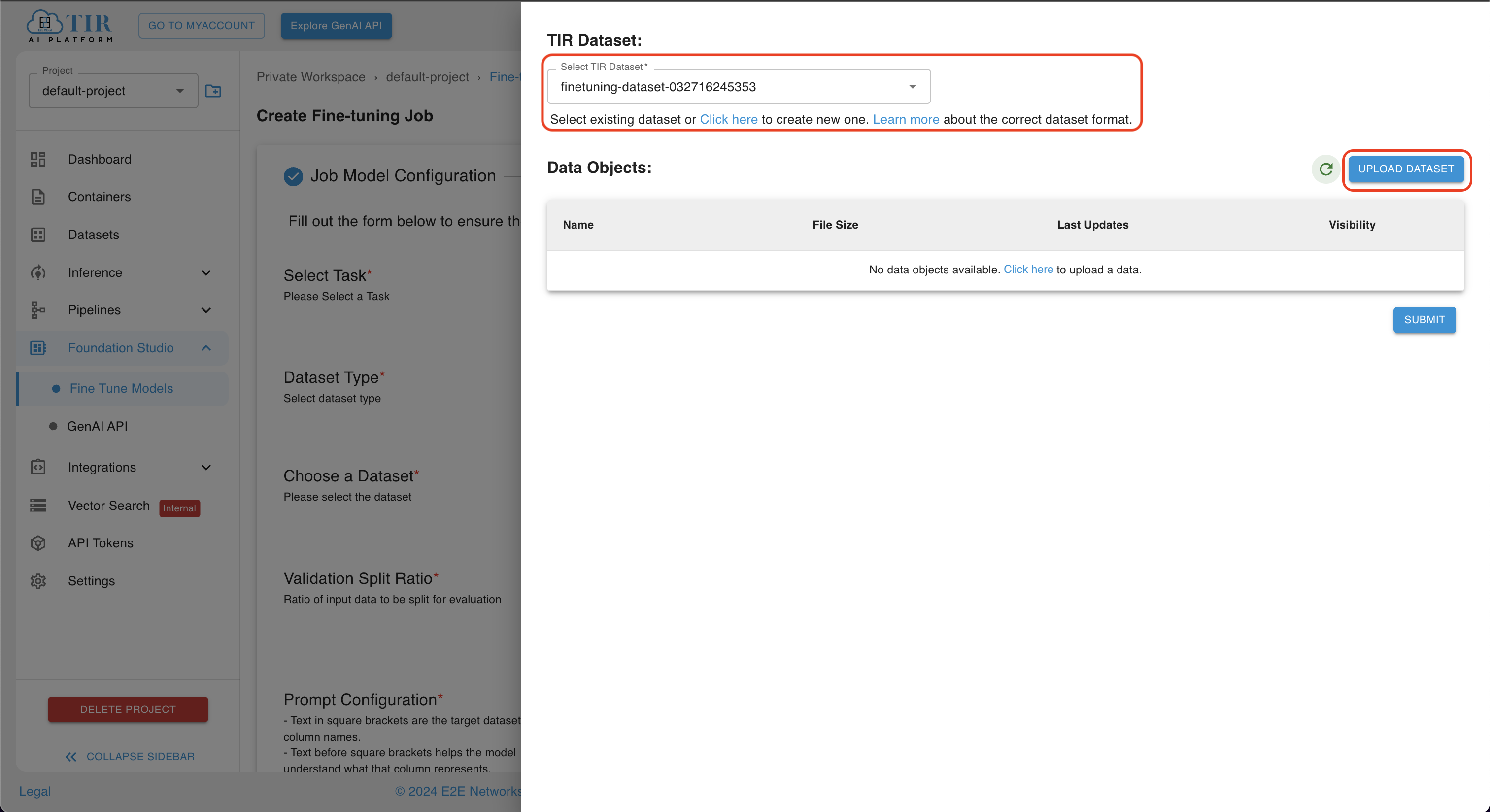
Click on
UPLOAD DATASETbutton and upload objects and click onUPLOADbutton.

After uploading objects to a specific dataset, choose a particular file to continue and then click on
SUBMITbutton.

How to define a Hyperparameter Configuration ?
Upon providing the dataset preparation details, users are directed to the
Hyperparameter Configurationpage. This interface allows users to customize the training process by specifying desired hyperparameters, thereby facilitating effective hyperparameter tuning. The form provided enables the selection of various hyperparameters, including but not limited to training type, epoch, learning rate, and max steps. Please fill out the form meticulously to optimize the model training process.
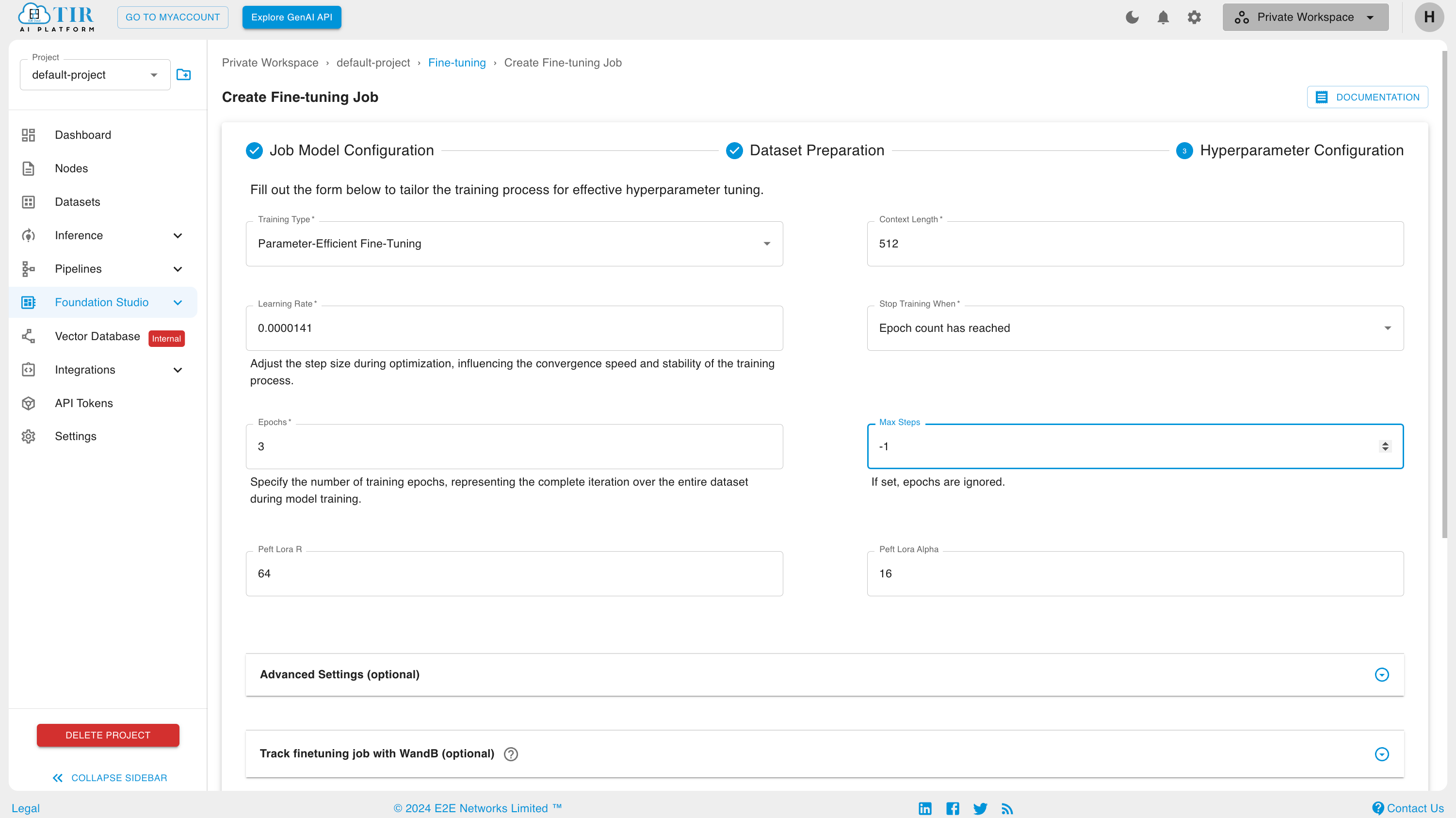
In addition to the standard hyperparameters, the configuration page offers advanced options such as batch size and gradient accumulation steps. These settings can be utilized to further refine the training process. Users are encouraged to explore and employ these advanced options as needed to achieve optimal model performance.
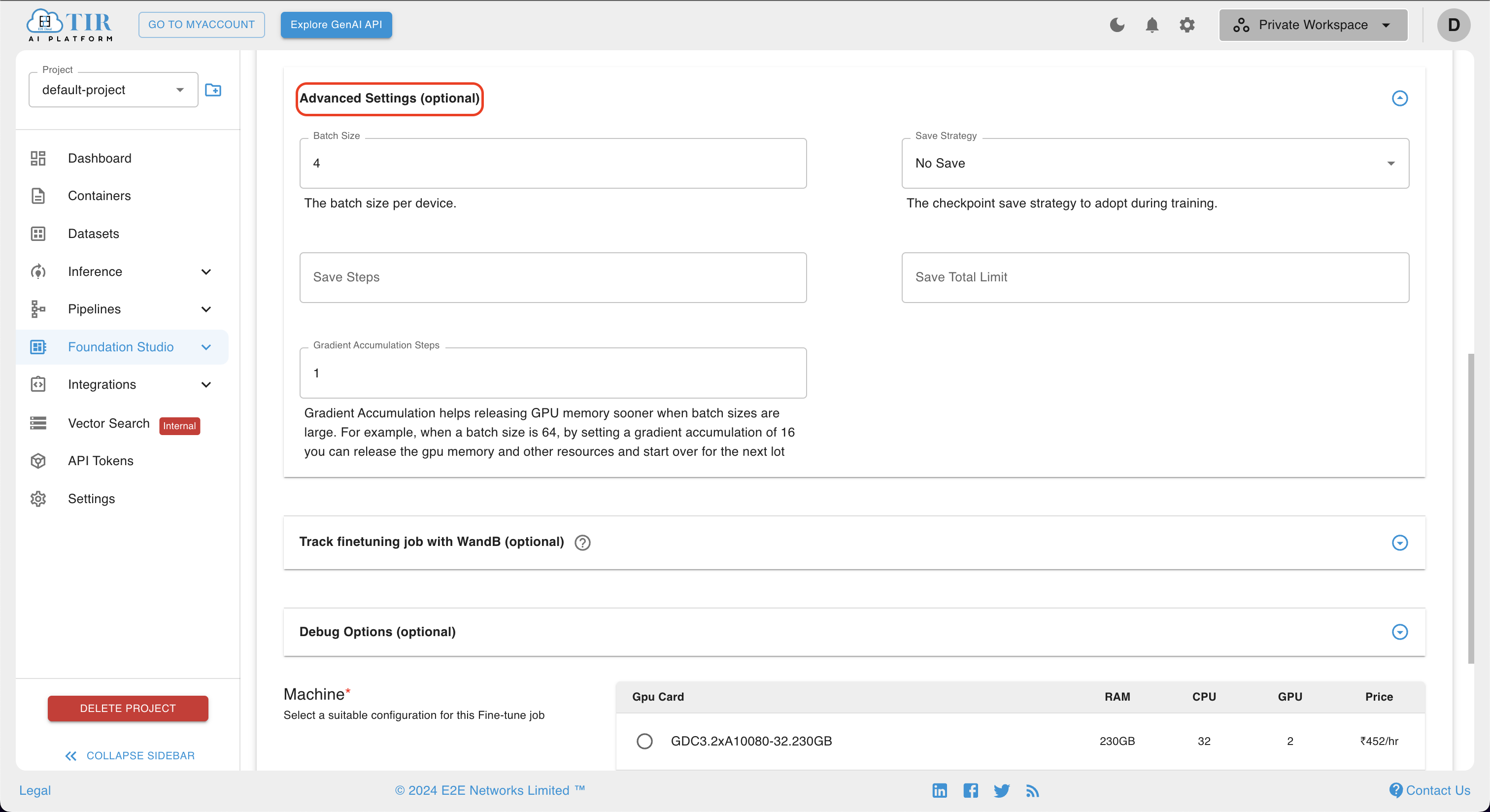
Upon specifying the advanced settings, users are advised to leverage the WandB Integration feature for comprehensive job tracking. This involves proceeding to fill in the necessary details in the provided interface. By doing so, users can effectively monitor and manage the model training process, ensuring transparency and control throughout the lifecycle of the job.
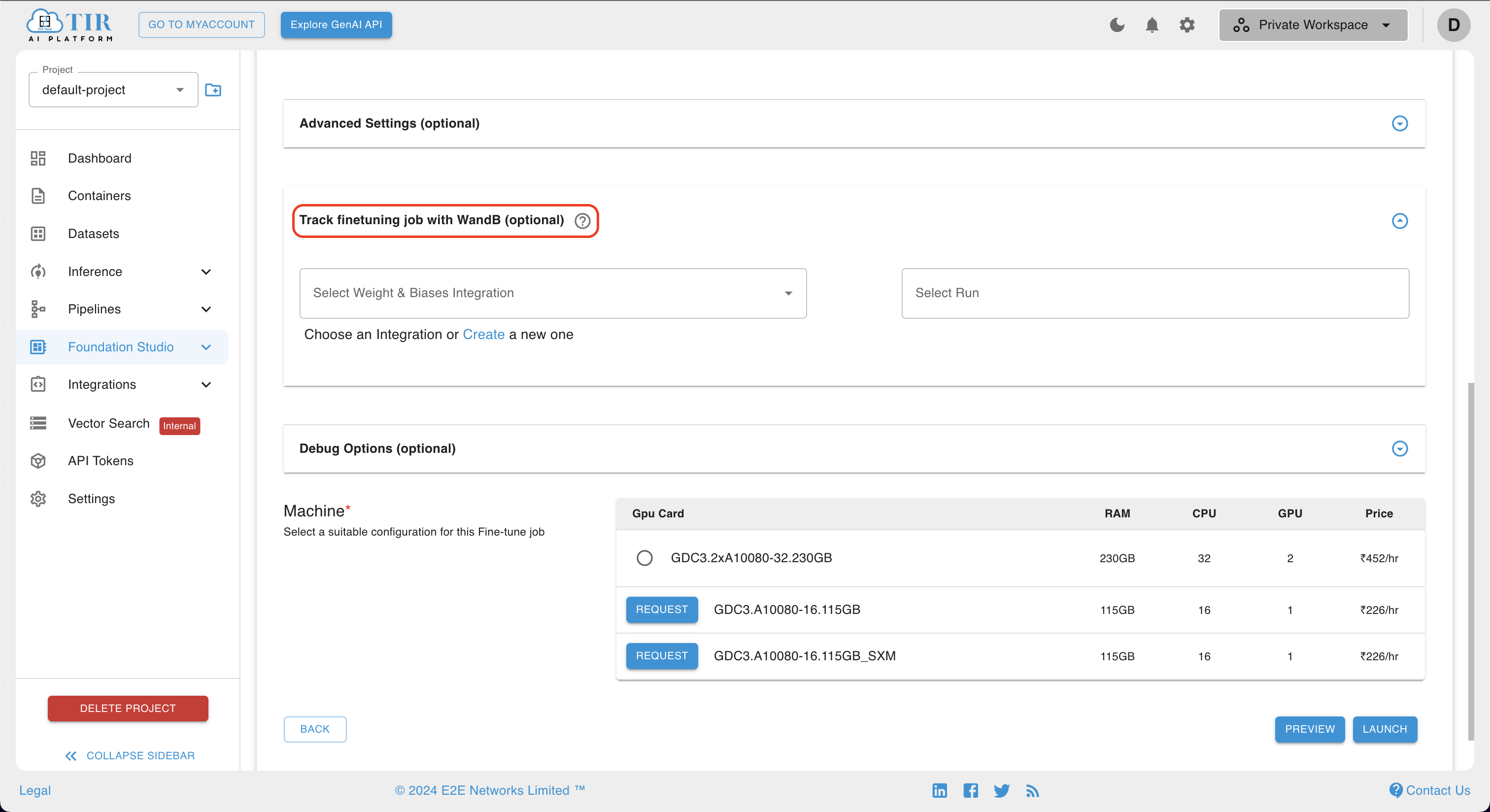
Also they can describe the
debugoption as desired for debugging purposes or quicker training.
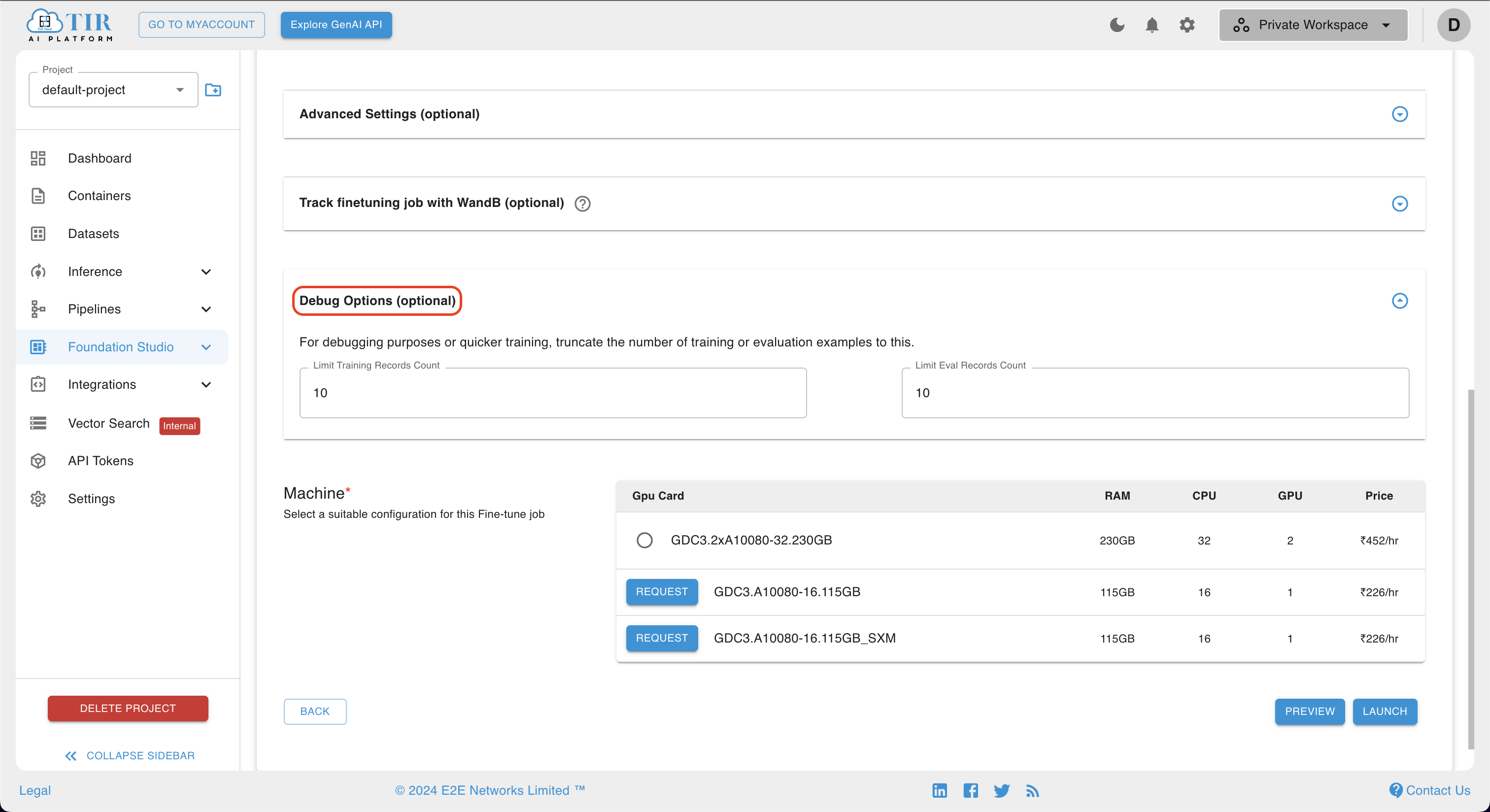
Once the debug option has been thoroughly addressed, users are required to select their preferred machine configuration for the finetuning job. Subsequently, clicking on the
LAUNCHbutton will initiate or schedule the job, depending on the chosen settings. To ensure fast and precise training, a variety of high-performance GPUs, such as Nvidia H100 and A100, are available for selection. This allows users to optimize their resources and accelerate the model training process.
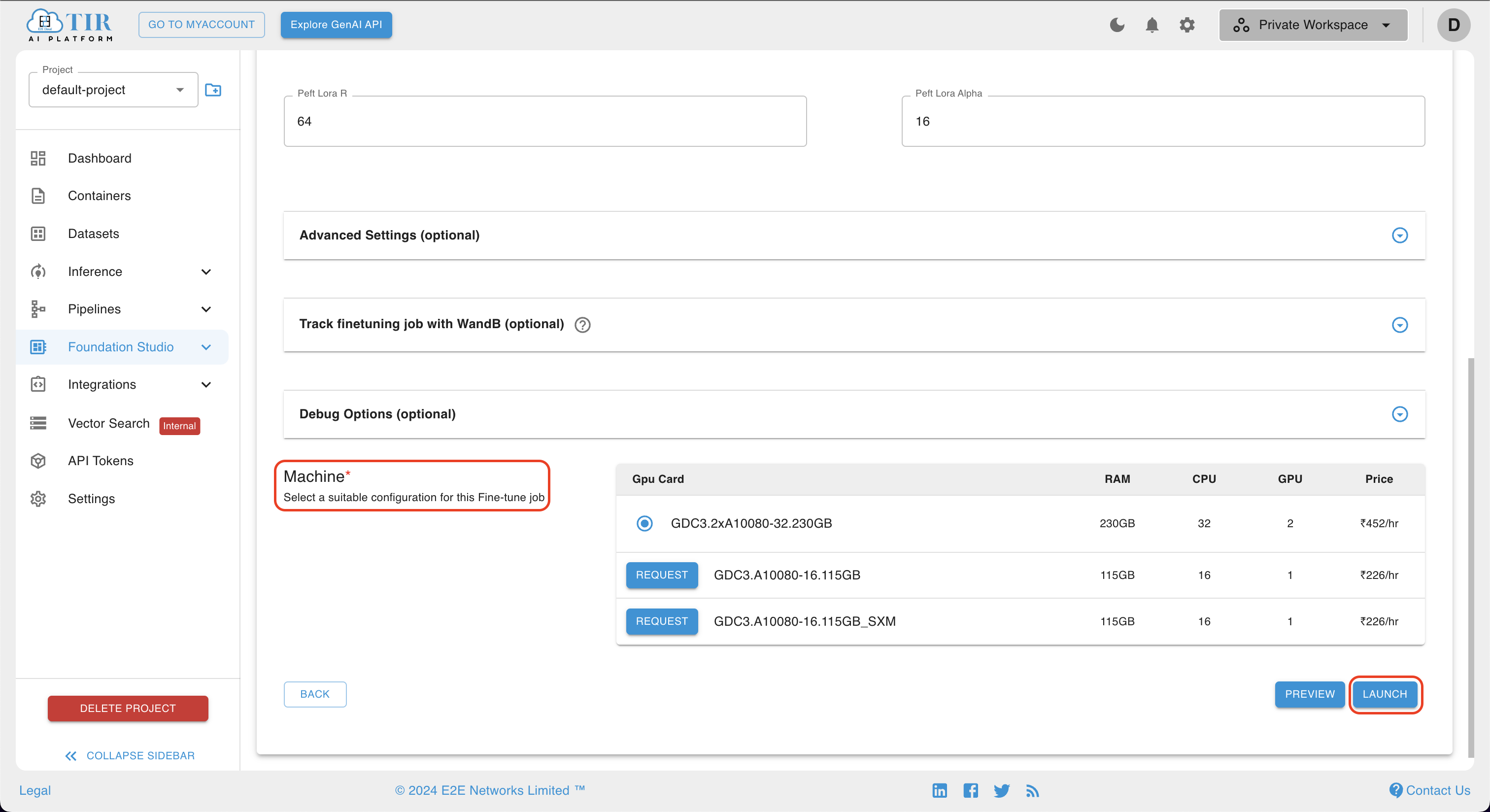
Viewing your Job parameters and Finetuned models ?
1. On completion of job, a Fine-Tuned model will be created and will be shown in models section in lower section of the page. This finetuned model repo will contain all checks-points of model training as well as adapters built during training. Users if they desire, can also directly go to model repo page under inference to view it.
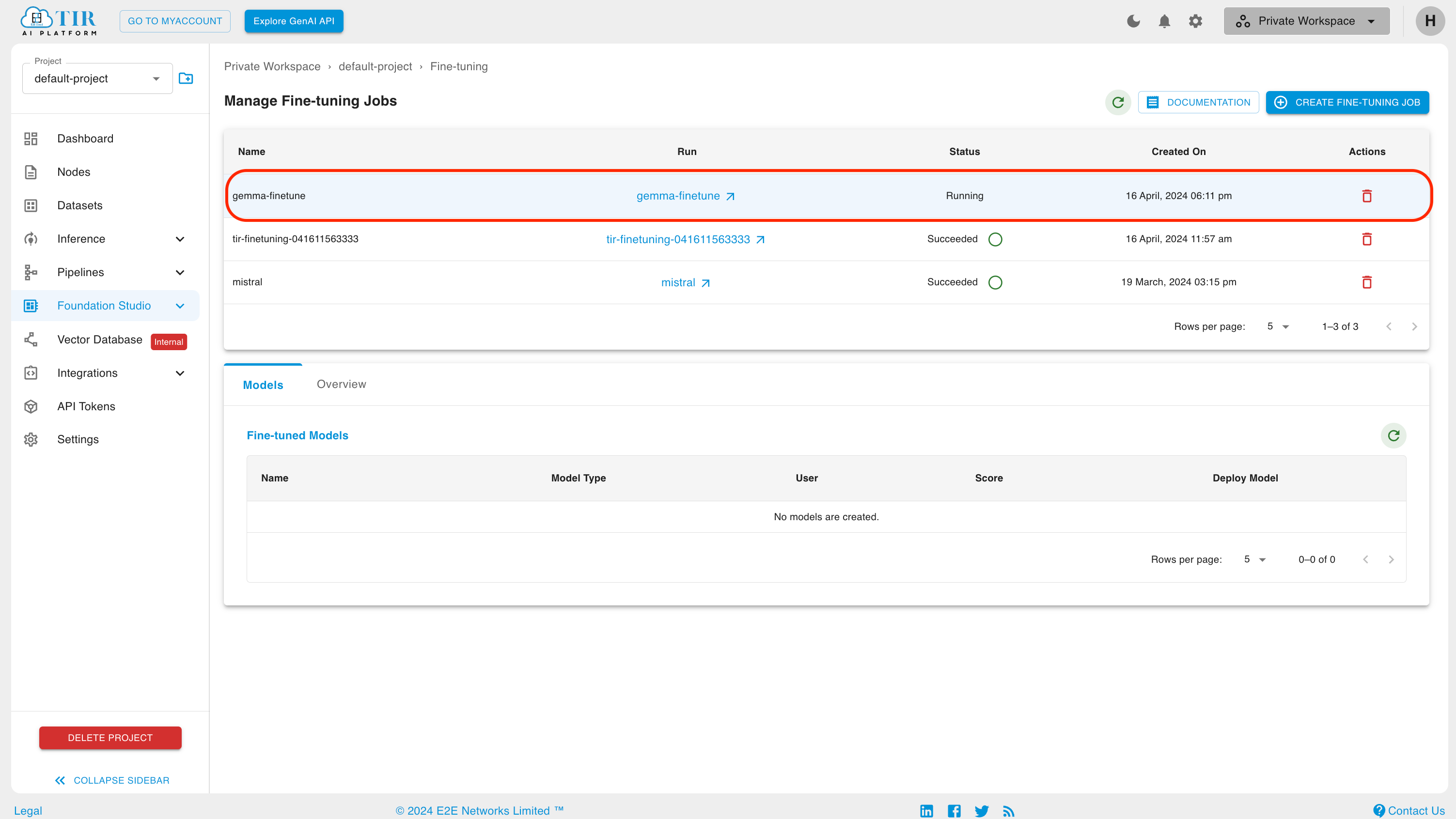
If desired the user can view job parameter details in overview section of the job as shown below.
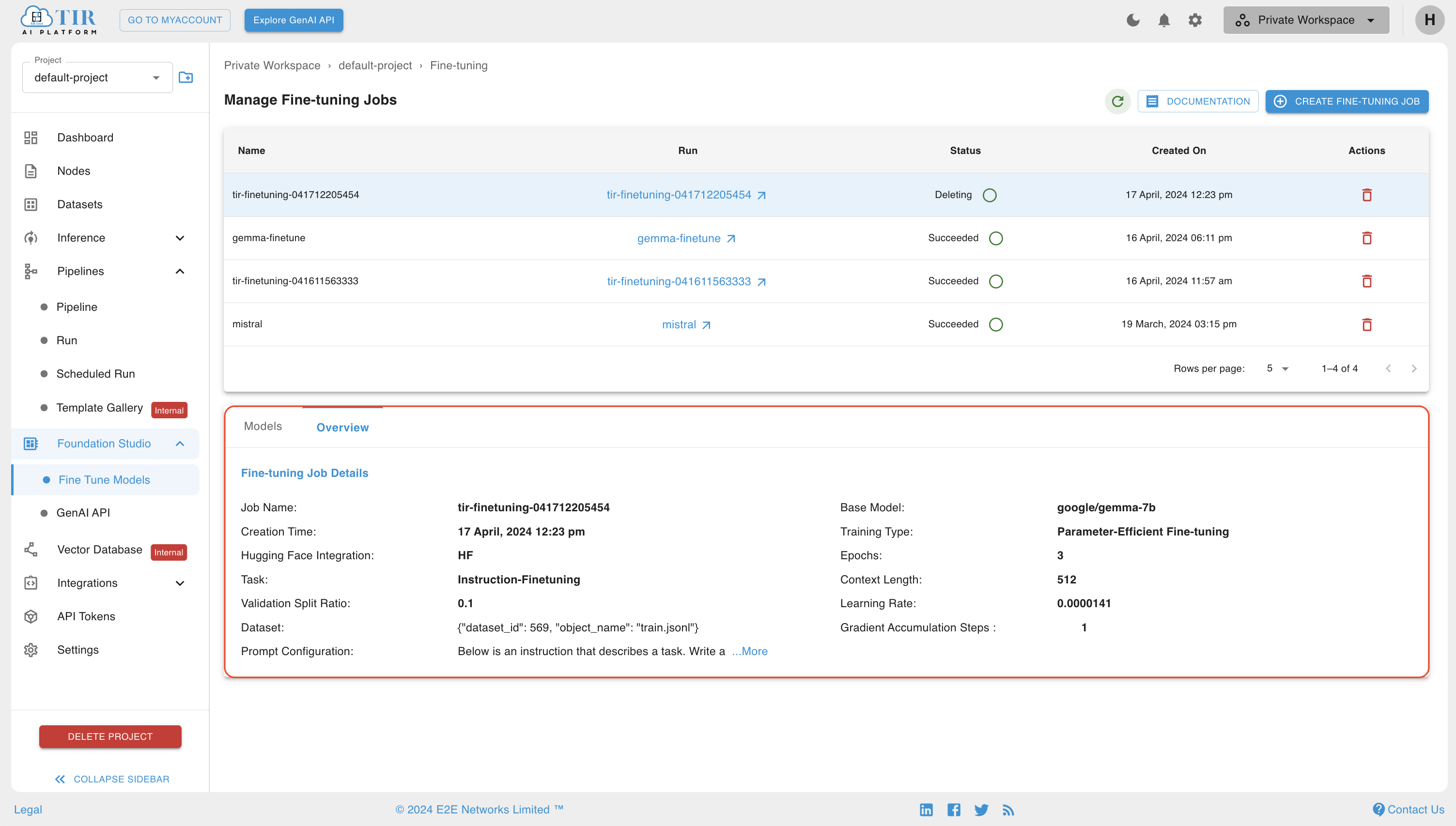
Users can effortlessly access the logs of the model training by clicking on the run of the fine-tuning job they’ve created. These logs serve as a valuable resource, aiding users in debugging the training process and identifying any potential errors that could impede the model’s progress.
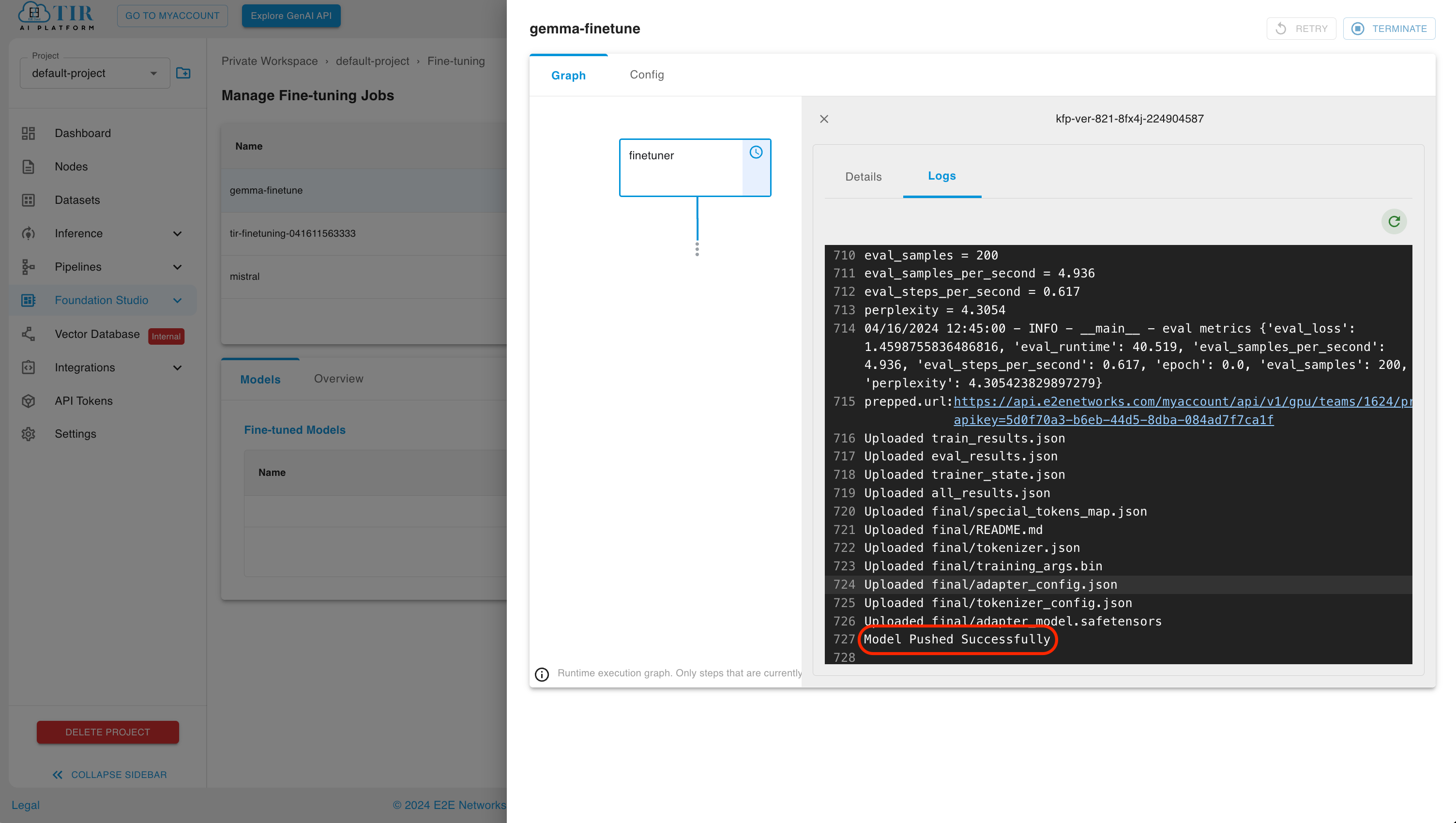
Upon successful completion of training, the model will be seamlessly pushed, ensuring smooth integration with our existing model infrastructure.
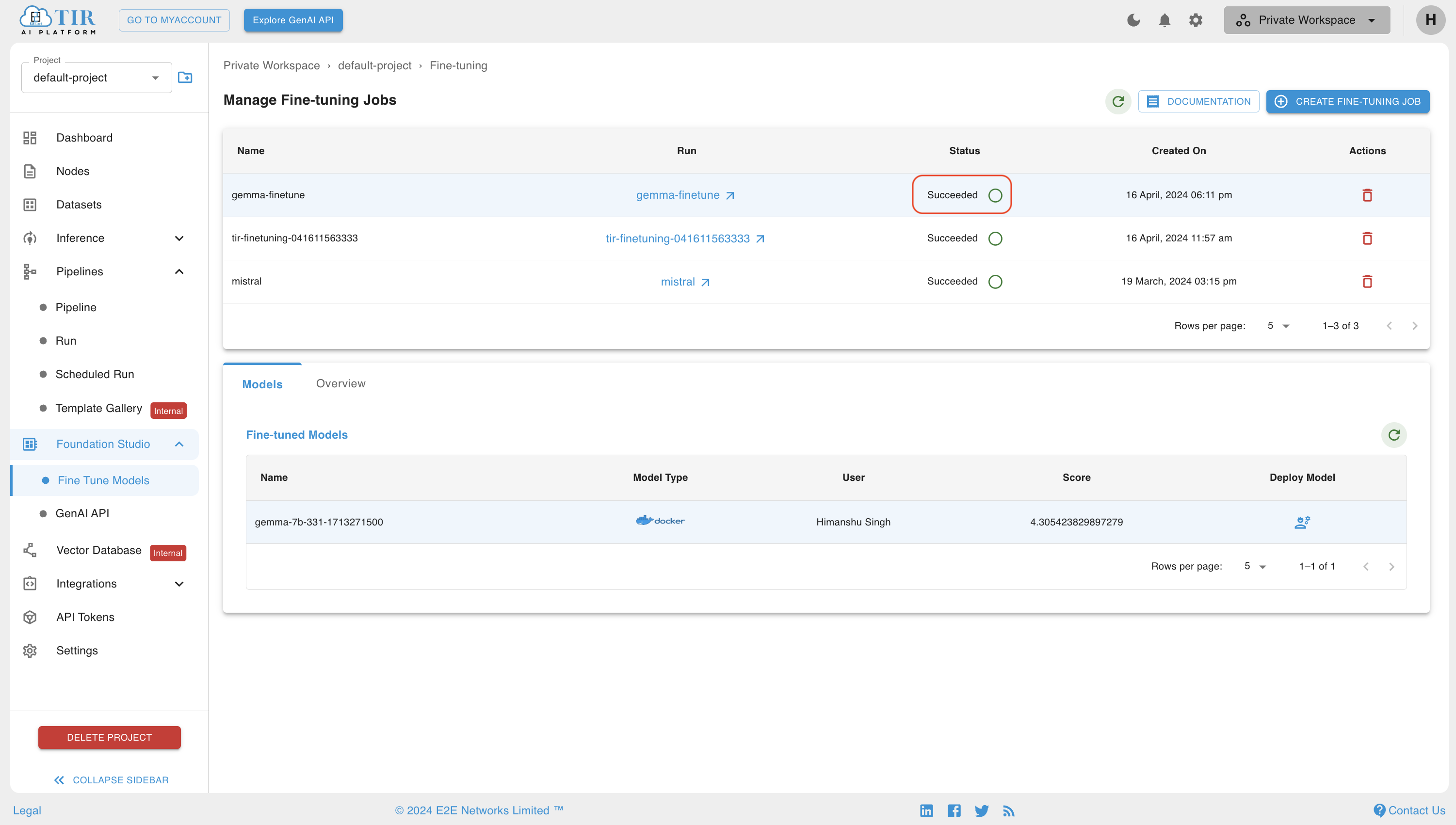
Running infernece on Finetuned Gemma-7b model ?
Upon successful completion of model training, the fine-tuned Gemma-7b model can be conveniently accessed and viewed under the Models section.
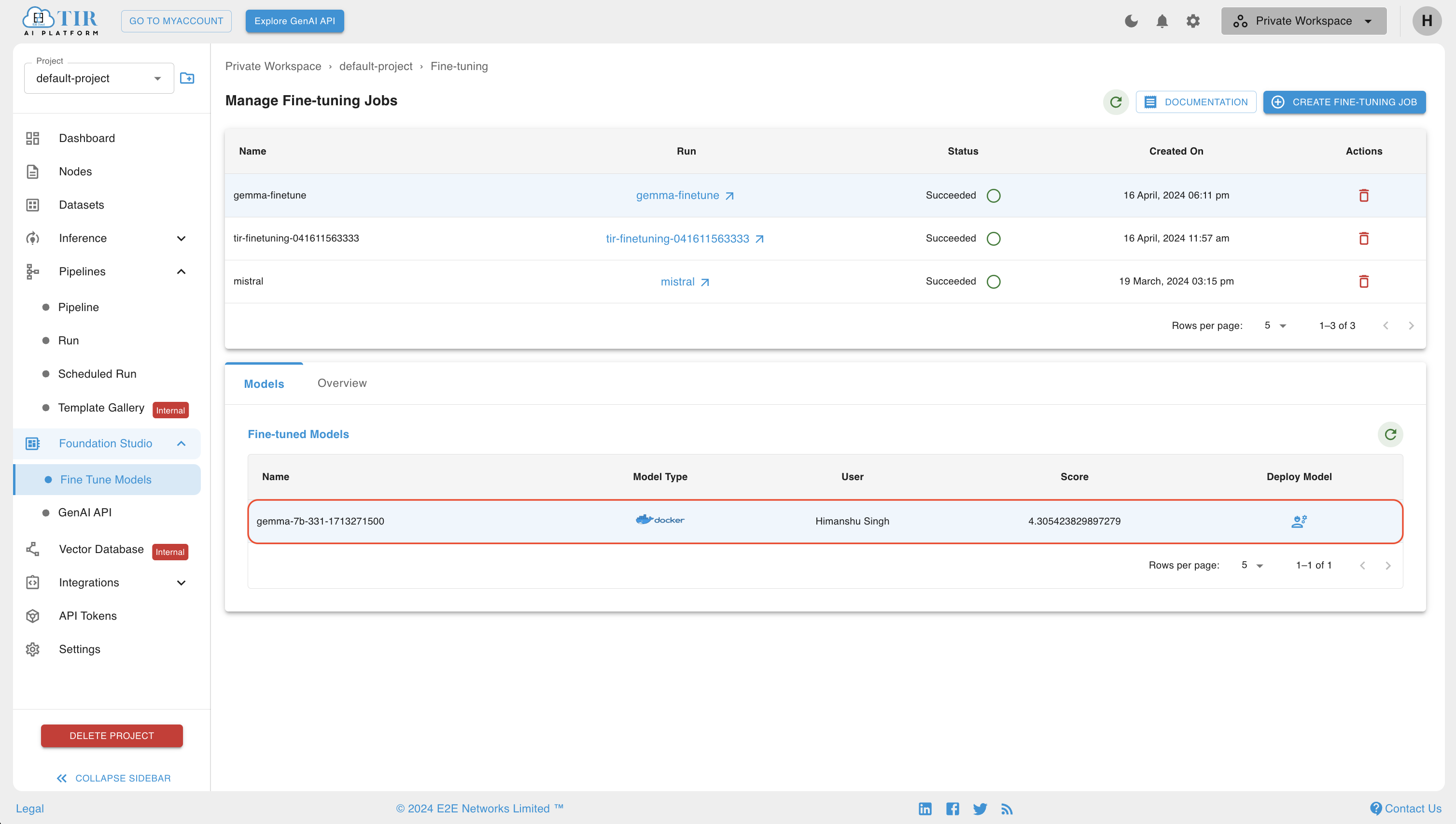
Deployment of finetuned Gemma-7b
Selecting the Deploy icon reveals a sidebar featuring different menus, including Resource details, Endpoint details and Environment Variables.
Within the
Resource detailsmenu, users can specify their desired CPU/GPU configuration and set the number of replicas. Once configurations are finalized, users can proceed by clicking on theNextbutton.
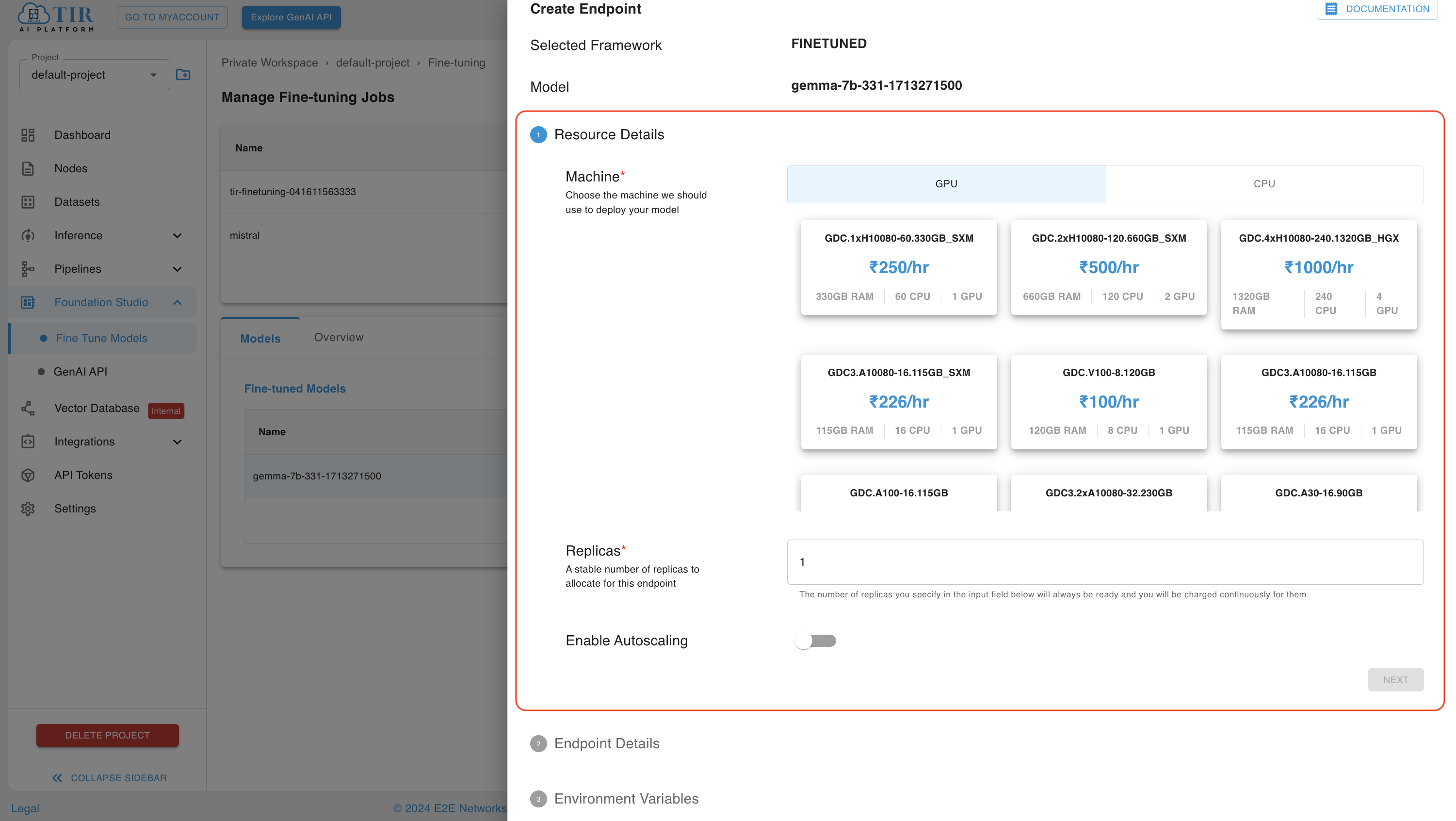
In the
Endpoint detailssection, users can either enter a custom name for the endpoint or opt to use the default name provided. We have used the default name.
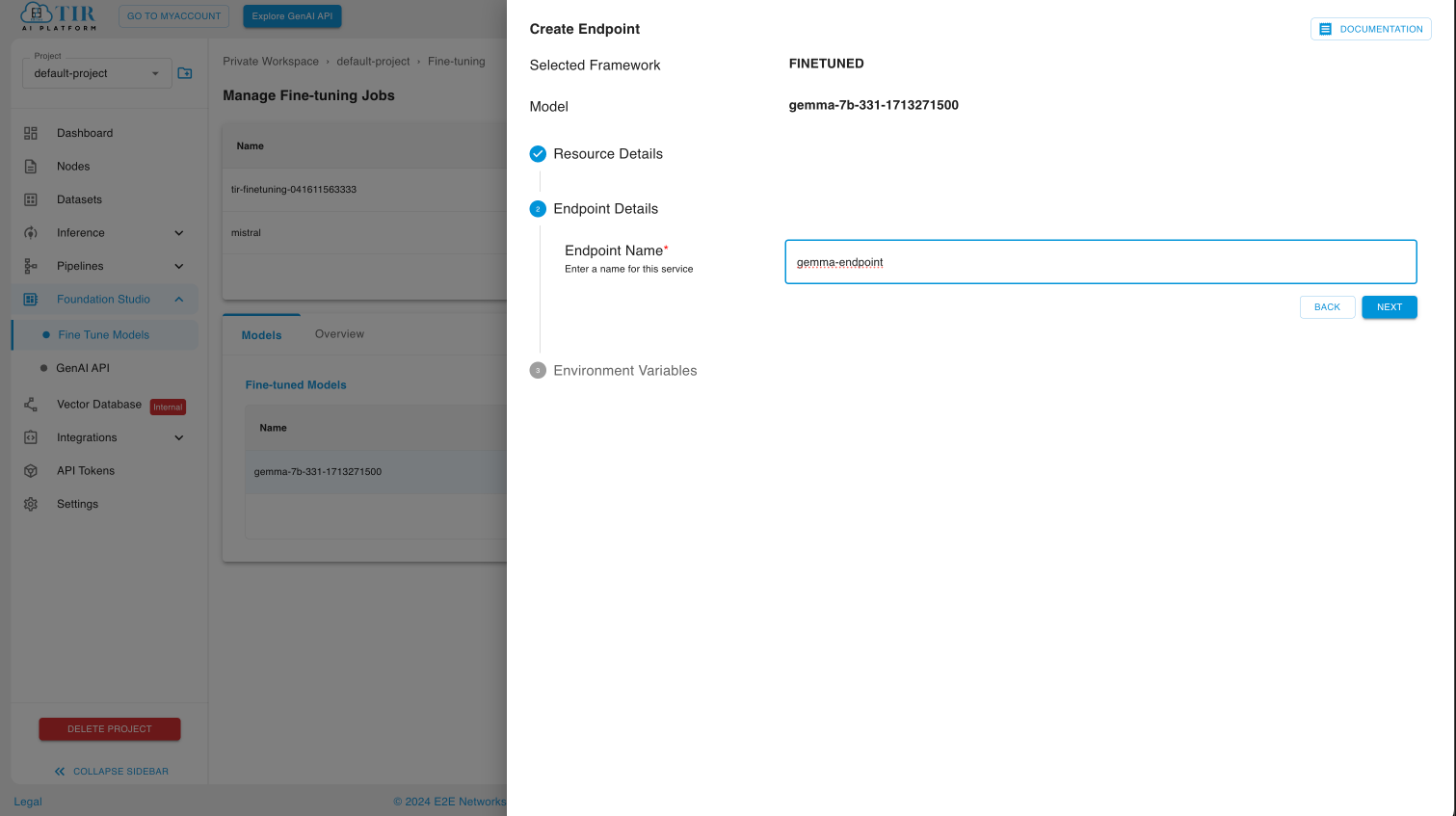
In the
Environment Variablessection, input your HuggingFace token for authentication purposes.

Following the completion of the aforementioned steps, proceed by selecting the
Createoption. This action will initiate the creation process for your model endpoint.

Running inference on the Model Endpoint
Navigate to the Inference section and select the Model Endpoint option to access the details of your created model endpoint. Here, you can monitor the status of your model endpoint. Once the status changes to Running, you can proceed by clicking on the API Request icon to make requests to your endpoint.
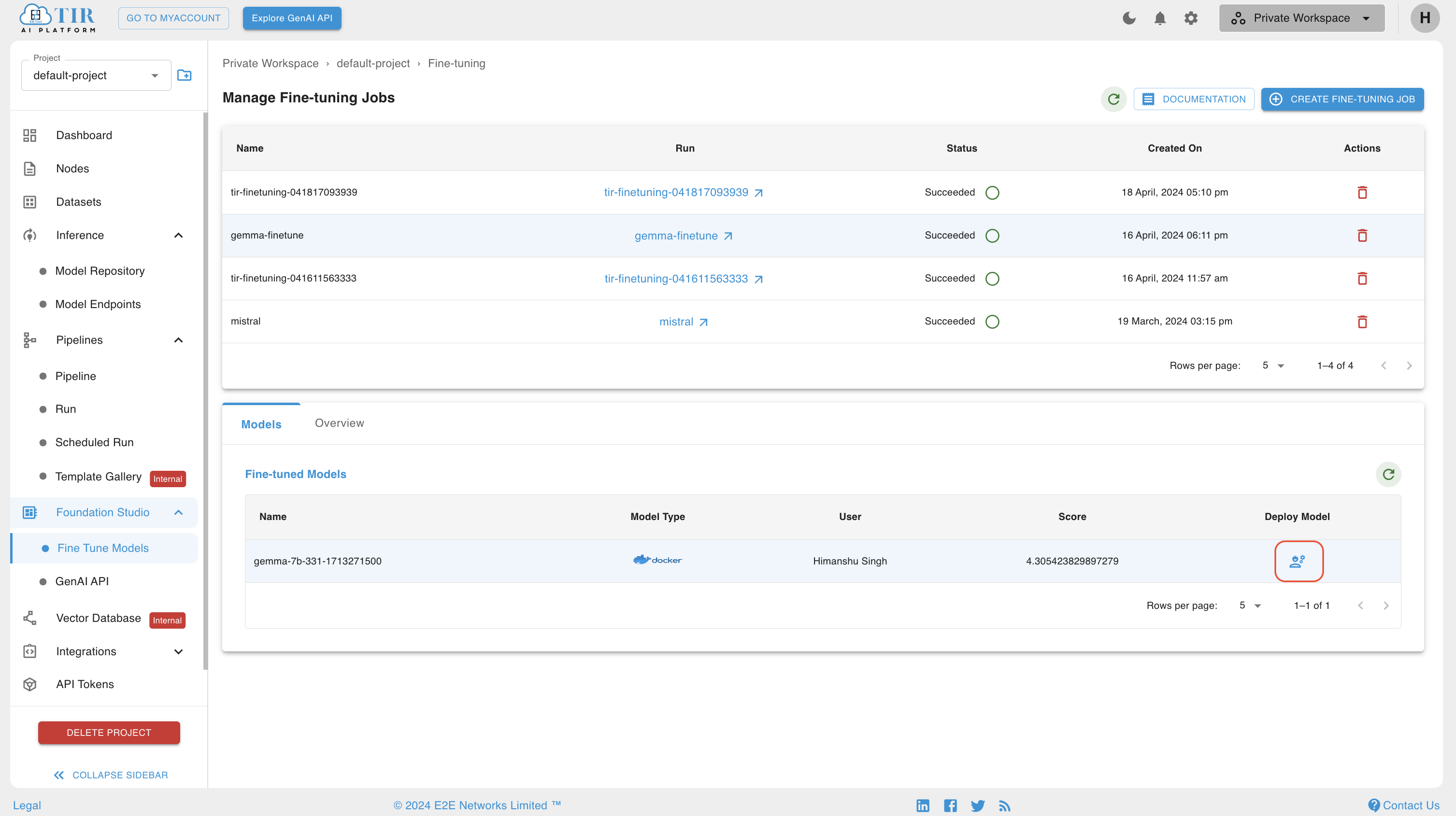
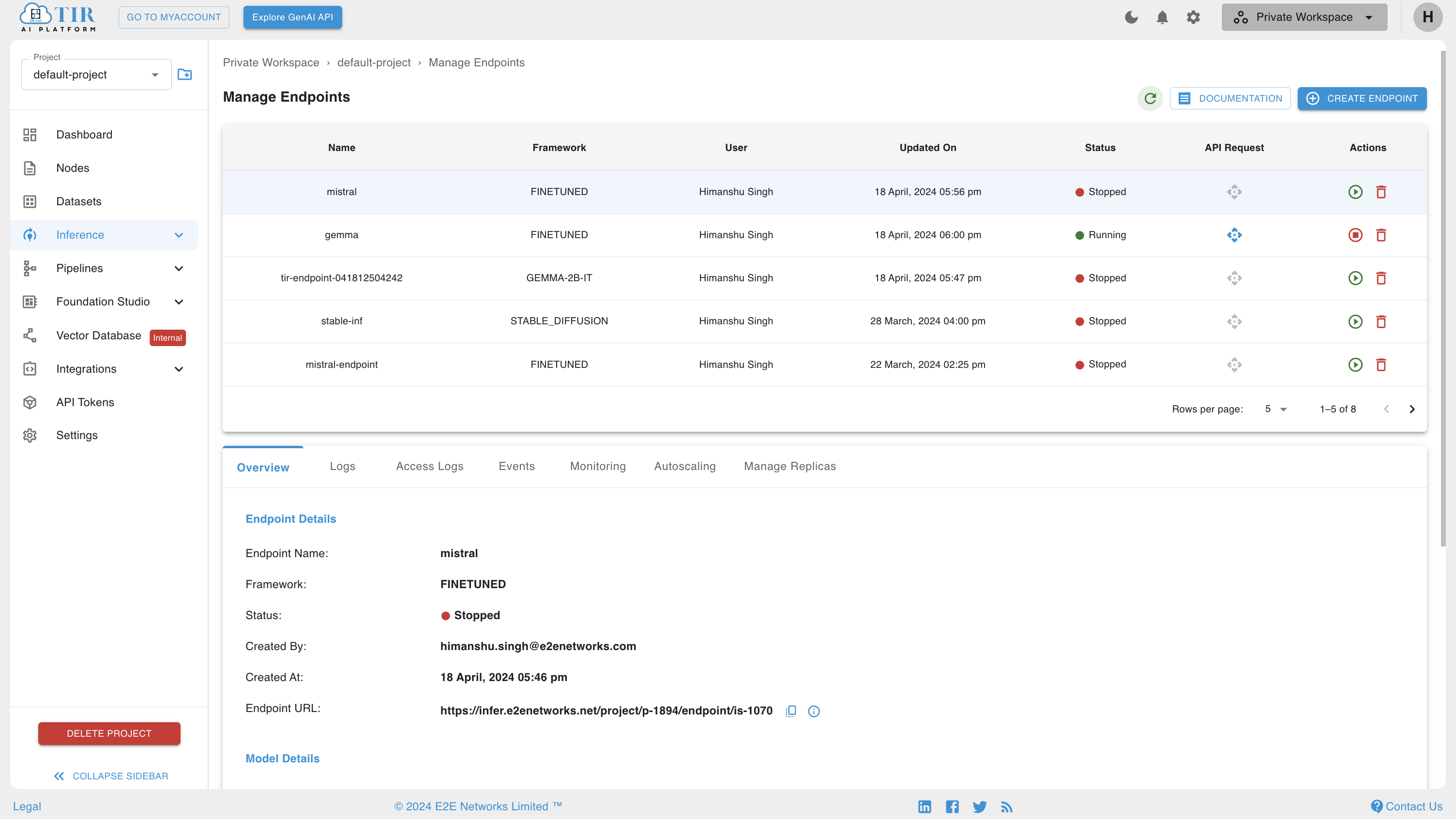
A sidebar menu titled Sample API Request will appear. Within this menu, you have two options for running inference:
Curl Script: Execute the provided curl script on your terminal of your local machine.

Python Script: Run the provided Python script on your terminal or any code editors of your choice.
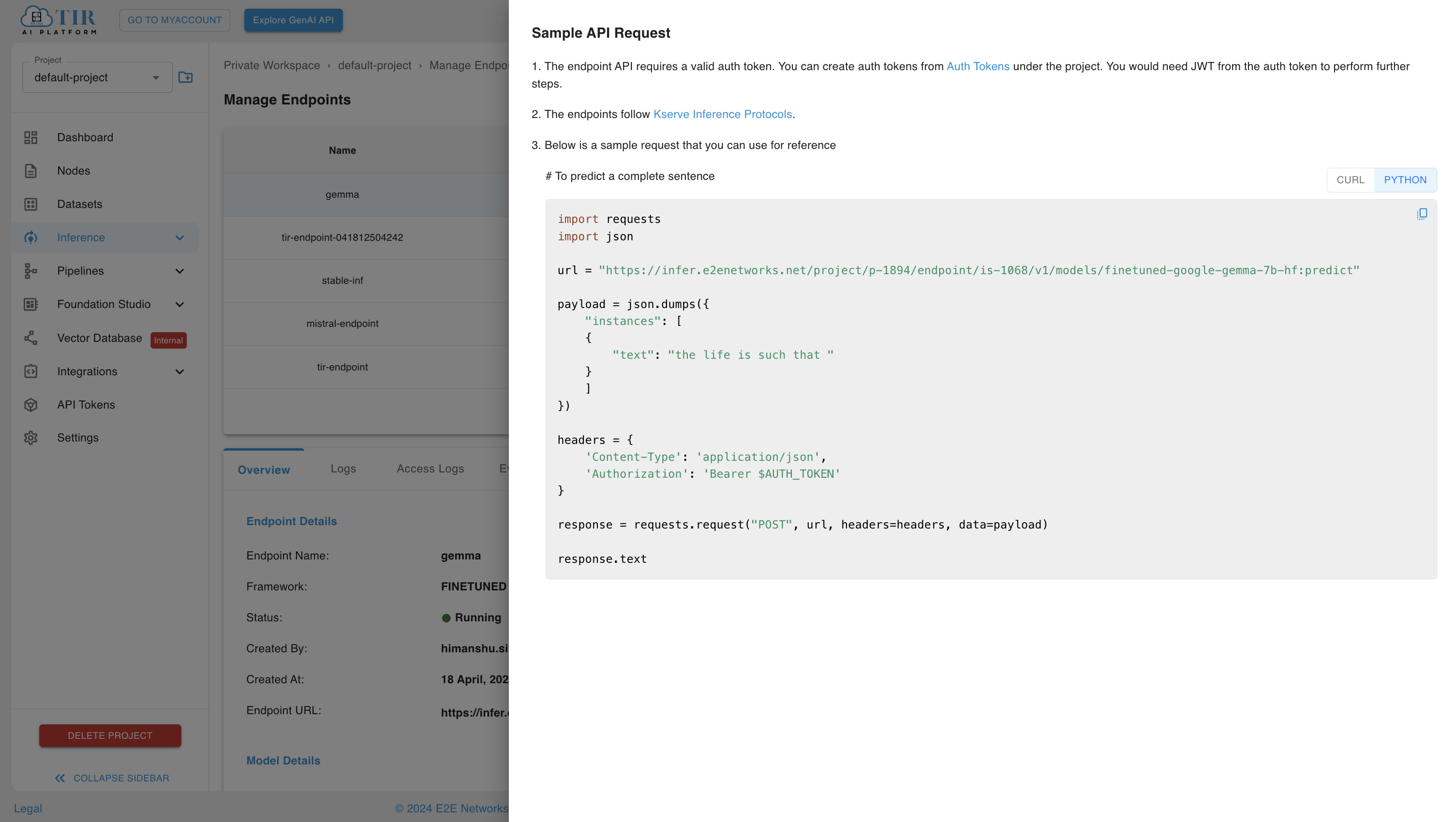
Note
Ensure to replace the placeholder $AUTH_TOKEN in the script with your actual API authentication token. You can locate your authentication token in the “API Tokens” section. If you don’t have an authentication token, you can generate a new one from the same section.
For Authentication refer this Documentation Click here

